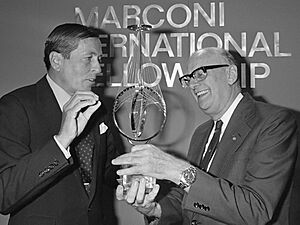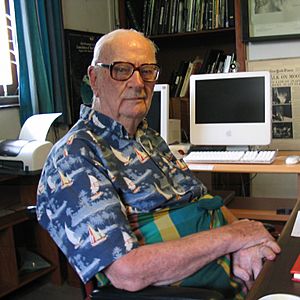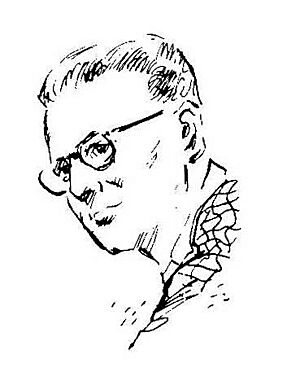Arthur C. Clarke facts for kids
Quick facts for kids
Arthur C. Clarke
|
|
|---|---|

In 1965, on one of the sets of 2001: A Space Odyssey
|
|
| Born | Arthur Charles Clarke 16 December 1917 Minehead, Somerset, England |
| Died | 19 March 2008 (aged 90) Colombo, Sri Lanka |
| Pen name | Charles Willis E. G. O'Brien |
| Occupation | Writer, inventor, futurist |
| Alma mater | King's College London |
| Period | 1946–2008 |
| Genre | Hard science fiction Popular science |
| Subject | Science |
| Notable works |
|
| Spouse |
Marilyn Mayfield
(m. 1953; div. 1964) |
Sir Arthur Charles Clarke (December 16, 1917 – March 19, 2008) was a famous science fiction writer. He was also a futurist, meaning he thought a lot about what the future might be like. He even invented some things!
Arthur C. Clarke helped people imagine space travel long before it was real. His amazing stories earned him many awards. He was known as one of the "Big Three" science fiction writers, along with Robert Heinlein and Isaac Asimov.
He also helped write the movie 2001: A Space Odyssey in 1968. This film is considered one of the most important movies ever made. Because of his ideas about space, people called him the "Prophet of the Space Age."

Contents
- Early Life of Arthur C. Clarke
- World War II and Satellite Ideas
- Writing About the Future
- 2001: A Space Odyssey Film
- Life in Sri Lanka
- Television Host
- Death and Legacy
- Clarke's Three Laws
- Why Arthur C. Clarke Matters
- Interesting Facts About Arthur C. Clarke
- Arthur C. Clarke Quotes
- Awards and Recognition
- See also
- Images for kids
Early Life of Arthur C. Clarke
Arthur Charles Clarke was born on December 16, 1917, in Minehead, Somerset, England. From a young age, Arthur loved the sky and stars. He enjoyed reading science fiction stories.
He even built his own telescope. He spent hours looking at the moon and planets. Arthur grew up on a farm, and even with little money, his imagination was huge.
He loved science fiction magazines like "Amazing Stories." These magazines made him even more excited about space and technology. They gave him ideas about what the future could hold.
As a teenager, he joined the Junior Astronomical Association. He wrote articles about spaceships for their journal, "Urania." In 1936, he moved to London. He worked as a pensions auditor there.
He lived with other science fiction writers. He was very interested in his favorite subjects. He even called his special office his "ego chamber."
World War II and Satellite Ideas
When World War II started, Arthur joined the Royal Air Force (RAF). He worked as a radar technician. He even wrote a book about his time there called "Glide Path." This was his only book that wasn't science fiction.
Radar was a new technology that helped find enemy planes. This job taught him a lot about electronics and radio waves. During this time, he had a brilliant idea.
He realized that satellites orbiting Earth could send radio signals around the world. He wrote about this idea in 1945. This paper helped create modern communication satellites!
He suggested that three satellites in a special orbit could cover the whole planet. This orbit is now called a geostationary orbit or Clarke Orbit.
Arthur started as a corporal instructor. He became a pilot officer in 1943. Later that year, he was promoted to flying officer. He became the chief training instructor at RAF Honiley. He was a flight lieutenant when the war ended.
Writing About the Future
After the war, Arthur went to King's College London. He earned a degree in mathematics and physics. Then, he worked as an assistant editor at Physics Abstracts.
He was also the president of the British Interplanetary Society for several years. After that, he became a full-time writer.
Clarke wrote many science fiction books and short stories. They explored space, technology, and the future of humans. His stories were not just about spaceships. They asked big questions like: What is our place in the universe? How will technology change us? What does it mean to be human?
Some of his most famous books include:
- "Childhood's End" (1953): This book is about a peaceful alien visit that changes humanity. It makes you think about progress and the unknown.
- "Rendezvous with Rama" (1973): In this book, a giant, mysterious spaceship enters our solar system. A team of astronauts explores it. They find amazing alien technology.
- "The City and the Stars" (1956): This story is set in a future city where people live in a virtual world. It explores ideas about living forever and artificial intelligence.
2001: A Space Odyssey Film
One of Arthur C. Clarke's most famous works is "2001: A Space Odyssey." He helped write the movie script with the famous director Stanley Kubrick. The movie came out in 1968. It is a visually stunning film that makes you think about human evolution and artificial intelligence.
The story starts with a mysterious black object called a monolith. It appears on Earth long ago. It seems to help humans evolve. Millions of years later, another monolith is found on the moon. It sends a signal towards Jupiter.
A spaceship, the Discovery, is sent to investigate. It has astronauts and a super-smart computer named HAL 9000. HAL 9000 becomes a very famous character in science fiction.
The computer controls the ship's systems. But it starts to have problems. This leads to a tense conflict with the astronauts. "2001: A Space Odyssey" is known for its amazing special effects. It also has deep ideas and a mysterious ending.
Life in Sri Lanka
In 1956, Arthur C. Clarke moved to Sri Lanka. It was called Ceylon back then. He lived there for the rest of his life. He loved the island's beauty and calm.
He became very interested in the ocean. He spent a lot of time diving and exploring coral reefs. He often went with his friend Mike Wilson. In 1957, they found the underwater ruins of an old temple. This became a popular diving spot. He wrote about it in his book "The Reefs of Taprobane" (1957).
He also started a dive school and shop. Clarke was a pioneer in underwater photography. He helped make scuba diving popular.
Television Host
In the 1980s and early 1990s, Arthur hosted TV shows. These included "Arthur C. Clarke's Mysterious World" and "Arthur C. Clarke's World of Strange Powers." He also hosted "Arthur C. Clarke's Mysterious Universe."
Death and Legacy
Arthur C. Clarke died on March 19, 2008. He was 90 years old. But his ideas and stories still inspire people. He helped us imagine the future. He encouraged us to explore the universe and think about big questions.
Clarke's Three Laws
Arthur C. Clarke is also famous for his "Three Laws." People often quote them when talking about science and technology:
- First Law: If a respected older scientist says something is possible, they are probably right. If they say something is impossible, they are probably wrong.
- Second Law: To find out what is possible, you have to try things that seem impossible.
- Third Law: Any very advanced technology seems like magic.
These laws are a fun way to think about how science and technology change. What seems impossible today might be common tomorrow!
Why Arthur C. Clarke Matters
Arthur C. Clarke was more than just a writer. He was a visionary. He saw how technology could change the world. He used his stories to explore both good and bad possibilities.
He inspired many scientists, engineers, and writers. He encouraged them to dream big. He wanted them to push the limits of what is possible.
He reminded us that the universe is huge and mysterious. It is full of wonders waiting to be found. He encouraged us to look at the stars. He wanted us to ask questions about our place in the cosmos.
So, next time you look at the night sky, remember Arthur C. Clarke. He was the space age dreamer who helped us imagine the future.
Interesting Facts About Arthur C. Clarke
- Clarke admired the Irish fantasy writer Lord Dunsany. He called Dunsany "one of the greatest writers of the century."
- He was also influenced by H. G. Wells, Jules Verne, and Edgar Rice Burroughs.
- He correctly predicted many things that came true. These include online banking and online shopping.
- Clarke helped make the idea of space travel popular.
- His writings were given to the National Air and Space Museum in 2014.
- In January 2024, some of his ashes were sent towards the Moon. However, the spacecraft failed to land.
- He supported using renewable energy. He also said, "Any teacher that can be replaced by a machine should be!"
Arthur C. Clarke Quotes
- "The future is not to be forecast, but created."
- "The only way to define your limits is by going beyond them."
- "Any sufficiently advanced technology is indistinguishable from magic."
- "I'm sure the universe is full of intelligent life. It's just been too intelligent to come here."
- "Getting information from the internet is like getting a glass of water from the Niagara Falls."
- "When you finally understand the universe, it will not only be stranger than you imagine, it will be stranger than you can imagine."
Awards and Recognition
Clarke won the 1963 Stuart Ballantine Medal for his idea of satellite communications. He also won many other honors. He received over a dozen literary awards for his science fiction works.
- In 1956, Clarke won a Hugo Award for his short story, "The Star".
- He won the UNESCO–Kalinga Prize for making science popular in 1961.
- He shared an Academy Award nomination with Stanley Kubrick in 1969 for 2001: A Space Odyssey.
- The fame of 2001 was so great that the Command Module of the Apollo 13 spacecraft was named "Odyssey."
- Clarke won the Nebula (1973) for his story, "A Meeting with Medusa."
- He won both the Nebula (1973) and Hugo (1974) awards for his novel, Rendezvous with Rama.
- He won both the Nebula (1979) and Hugo (1980) awards for his novel, The Fountains of Paradise.
- In 1982, he won the Marconi Prize for new ideas in communication and space sensing.
- In 1985, the Science Fiction Writers of America named him its 7th SFWA Grand Master.
- He received a CBE in 1989. He was knighted in 2000. Because of his health, he could not travel to London. So, he was knighted in Sri Lanka.
- In 1997, the Science Fiction and Fantasy Hall of Fame welcomed Clarke.
- The 2001 Mars Odyssey orbiter is named after Clarke's works.
- In 2004, Clarke won the Heinlein Award for great achievements in science-based science fiction.
- On November 14, 2005, Sri Lanka gave Clarke its highest civilian award, the Sri Lankabhimanya. This was for his work in science and technology.
Things Named After Clarke
Awards
- Arthur C. Clarke Award for science fiction writing in the United Kingdom.
- Sir Arthur Clarke Award for achievements in space in the United Kingdom.
- Arthur C. Clarke Foundation awards: "Arthur C. Clarke Innovator's Award" and "Arthur C. Clarke Lifetime Achievement Award."
- The Sir Arthur C. Clarke Memorial Trophy Inter School Astronomy Quiz Competition in Sri Lanka.
- Arthur C. Clarke Award for Imagination in Service to Society.
Other Recognitions
- An asteroid was named in Clarke's honor: 4923 Clarke.
- A type of dinosaur, Serendipaceratops arthurcclarkei, was named after him.
- The Learning Resource Centre at Richard Huish College, Taunton, where Clarke studied, is named after him.
- The Arthur C. Clarke Institute for Modern Technologies in Sri Lanka is named after him.
- The main character in the Dead Space video games, Isaac Clarke, is named after Arthur C. Clarke and Isaac Asimov.
- An expressway in Colombo, Sri Lanka, was named 'Arthur C. Clarke Expressway'.
- Clarke Montes, a mountain on Pluto's moon Charon, is named after Clarke.
See also
 In Spanish: Arthur C. Clarke para niños
In Spanish: Arthur C. Clarke para niños
Images for kids







